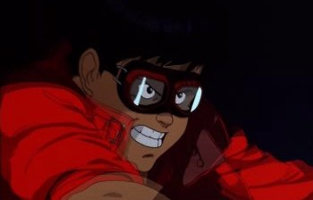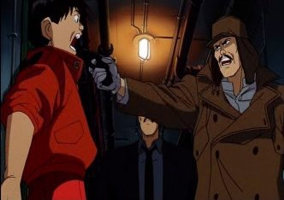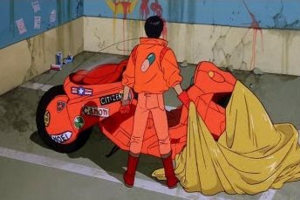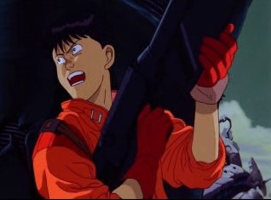Akira [1988]
Flash Gordon
(Anime Corner Staff Writer)
Pioneer Elite Plasma Display System PDP-5050SX
Denon AV Surround Receiver AVR-1801 with Dolby Digital/ DTS
Boston Acoustics Micro90T Die-Cast Surround Speakers including Subwoofer
Toshiba DVD SD-3755 Player with Dolby Digital/ DTS/ 3D Surround Sound.
MOTION PICTURE
R RATING
C+ ANIMATION
B- CHARACTER
A- MECH DESIGN
B MUSIC
B STORY
B FILM GRADE
STUDIO: AKIRA COMMITTEE COMPANY LTD.
DIRECTOR: KATSUHIRO OTOMO
PRODUCER: RYOHEI SUZUKI/ SHUNZO KATO
ANIMATOR: KATSUHIRO OTOMO/ TAKASHI NAKAMURA
DESIGNS: KATSUHIRO OTOMO
SCRIPT: IZO HASHIMOTO
MUSIC: GEINOH YAMASHIROGUMI/ SHOJI YAMASHIRO
DVD EXTRAS: PRODUCTION REPORT: THE MAKING OF AKIRA [48 min]/ SOUND CLIP FEATURETTE [19 min]/ DIRECTOR’S INTERVIEW [29 min]/ PRODUCTIONAL MATERIAL/ TRAILERS/ GLOSSARY/ RESTORING AKIRA/ 5.1 DTS JAPANANESE REMIX/ DIGITALLY REMASTERED
|
| DVD BREAKDOWN |
Other Works By Katsuhiro Otomo |
| REVIEW (Warning:
Spoilers Ahead!) |
Akira was not the film that turned me on to anime as it did for so many. In fact, how many times have you heard critics or fans express some variation on the following: “If you’re serious about anime or a true otaku, then Akira is required viewing and you must see it- it is mandatory viewing and is essential to your anime library.” If you have not seen it, the very imperative leaves you frozen with fear that you may well be discovered as some kind of anime fraud, looking over your shoulder in paranoia and asking yourself ‘could people know the truth about me’? The very suggestion you might be missing out on something this ‘BIG’
 leaves you desperate to see Akira. Might the seas part after witnessing this celluloid wonder? You might be led to believe if you don’t see it immediately after heeding such warnings you may well perish a horrible death where every limb of your being could shrivel and leave you a withered and crusty, fly-ridden stump of flaking decay. After all, it is ranked as one of anime’s all-time best. Yes! Akira is an absolute ‘must see’ for otaku! End of story - close the book! You need look no further for any true enlightenment. Okay, I’m tempting fate here and the potential for a one-way ticket to hell in a hand basket after being cheeky about this one. There is undeniably considerable talent at work here, but this will most assuredly be one of THE dissenting opinions and to even brave this road feels a bit like sacrilege. Being in the minority, albeit opinions are sometimes divided on the subject, this report offers a different take on Akira. Akira is disappointing. ‘WHAT!? BLASPHEMY! There must be some mistake!’ Could it be my undoing was to make Akira the roughly third anime installment ever viewed? Perhaps my anime sensibilities had not been finely-tuned enough to appreciate what has often been heralded as the end-all-be-all of anime classics. Maybe I unfairly placed it on the golden pedestal following the heaps of praise bestowed upon the film by writers like Roger Ebert who treasured its “bleak” tone and justifiably respected its “state of the art” animation. He has become a voice and proponent of the genre. We have all heard the reviews extolling the many virtues surrounding Akira. In the end, it is not the anime masterpiece that has been force-fed the otaku populace, virtually willed upon anime fans for years. Akira’s timely arrival in 1988 granted its creator the prestigious position of being a proud heir to the anime tradition of a long line of artistic masters alongside names like the prolific Hayao Miyazaki or Mamoru Oshii. It would be disingenuous of me to deny my personal feelings and observations and simply proclaim that Otomo belongs with such amazing company, but such a case can be justified. Akira’s reputation precedes itself, but the myth of Akira being cultivated as a work of anime perfection cannot be fully supported by this writer.
leaves you desperate to see Akira. Might the seas part after witnessing this celluloid wonder? You might be led to believe if you don’t see it immediately after heeding such warnings you may well perish a horrible death where every limb of your being could shrivel and leave you a withered and crusty, fly-ridden stump of flaking decay. After all, it is ranked as one of anime’s all-time best. Yes! Akira is an absolute ‘must see’ for otaku! End of story - close the book! You need look no further for any true enlightenment. Okay, I’m tempting fate here and the potential for a one-way ticket to hell in a hand basket after being cheeky about this one. There is undeniably considerable talent at work here, but this will most assuredly be one of THE dissenting opinions and to even brave this road feels a bit like sacrilege. Being in the minority, albeit opinions are sometimes divided on the subject, this report offers a different take on Akira. Akira is disappointing. ‘WHAT!? BLASPHEMY! There must be some mistake!’ Could it be my undoing was to make Akira the roughly third anime installment ever viewed? Perhaps my anime sensibilities had not been finely-tuned enough to appreciate what has often been heralded as the end-all-be-all of anime classics. Maybe I unfairly placed it on the golden pedestal following the heaps of praise bestowed upon the film by writers like Roger Ebert who treasured its “bleak” tone and justifiably respected its “state of the art” animation. He has become a voice and proponent of the genre. We have all heard the reviews extolling the many virtues surrounding Akira. In the end, it is not the anime masterpiece that has been force-fed the otaku populace, virtually willed upon anime fans for years. Akira’s timely arrival in 1988 granted its creator the prestigious position of being a proud heir to the anime tradition of a long line of artistic masters alongside names like the prolific Hayao Miyazaki or Mamoru Oshii. It would be disingenuous of me to deny my personal feelings and observations and simply proclaim that Otomo belongs with such amazing company, but such a case can be justified. Akira’s reputation precedes itself, but the myth of Akira being cultivated as a work of anime perfection cannot be fully supported by this writer.
Akira is a film by artist Katsuhiro Otomo and it is a film adaptation of his popular manga series, which in turn is also based upon Otomo’s original short story Fireball [1979]. Thanks to Akira Otomo is often one of the more respected names associated with anime. Has Otomo earned the recognition to be classified among an elite few? The accolades have certainly been showered upon Otomo due to the singular result of this
 one production. Apart from Akira, Otomo acted as general director for the ensemble collaboration Katsuhiro Otomo Presents Memories. Apart from oversight on the project he helmed the segment entitled Cannon Fodder, a short film about a fortified city with a focused thirst for war. Other projects include Otomo’s penning of the screenplay for Metropolis [2001]. Further, he finally released the much publicized, much delayed, but highly anticipated Steamboy [2005]. Otomo made good use of the new technologies available for Steamboy creating a more visually impressive feast over and above Akira in his animation details. Still, these are few works from which to judge this infrequent talent and no one will discredit or discount Otomo’s passion for hand-drawn cels. The relative critical disillusionment of Steamboy added further speculation to Otomo’s recognition within the industry’s pantheon of the master animators, especially considering his relative outsider status to anime given his significant credentials rooted in manga. To enjoy animation, like comic books, one has to be lured into the experience by its art. While style does not substitute for material substance, it is almost a necessity to open one’s mind to the story through the art. To be upfront, the detailed cityscapes are a site to behold, but the character art of Otomo’s Akira left me uninspired whereby others would argue against such claims vehemently. Otomo’s visual flair while wholly unique shut me off to the experience to some degree [maybe those anime pupils are just too darn beady]. Still, Otomo is an original in his presentation, my opinion withstanding. Enjoyment of animation in and of itself is purely subjective and such arguments can be debated for hours. The art of Katsuhiro Otomo, setting biases aside, is one of a kind but negatively impacted my appreciation for the film as a whole.
one production. Apart from Akira, Otomo acted as general director for the ensemble collaboration Katsuhiro Otomo Presents Memories. Apart from oversight on the project he helmed the segment entitled Cannon Fodder, a short film about a fortified city with a focused thirst for war. Other projects include Otomo’s penning of the screenplay for Metropolis [2001]. Further, he finally released the much publicized, much delayed, but highly anticipated Steamboy [2005]. Otomo made good use of the new technologies available for Steamboy creating a more visually impressive feast over and above Akira in his animation details. Still, these are few works from which to judge this infrequent talent and no one will discredit or discount Otomo’s passion for hand-drawn cels. The relative critical disillusionment of Steamboy added further speculation to Otomo’s recognition within the industry’s pantheon of the master animators, especially considering his relative outsider status to anime given his significant credentials rooted in manga. To enjoy animation, like comic books, one has to be lured into the experience by its art. While style does not substitute for material substance, it is almost a necessity to open one’s mind to the story through the art. To be upfront, the detailed cityscapes are a site to behold, but the character art of Otomo’s Akira left me uninspired whereby others would argue against such claims vehemently. Otomo’s visual flair while wholly unique shut me off to the experience to some degree [maybe those anime pupils are just too darn beady]. Still, Otomo is an original in his presentation, my opinion withstanding. Enjoyment of animation in and of itself is purely subjective and such arguments can be debated for hours. The art of Katsuhiro Otomo, setting biases aside, is one of a kind but negatively impacted my appreciation for the film as a whole.
It is no overstatement, without question, Akira had a profound impact on the world of anime and its evolution. It is a landmark film, stunning in its day and for a number of reasons lays claim to being one of the elite classics in anime. Otomo’s look was certainly experimental and incredibly bloody upon its release and it was a clear break from traditional American animation norms adhered to by Disney. To achieve theatrical notoriety in 1988 was no small success. His distinctive, individually hand-drawn methods are painstaking and his efforts are grand with stylistic ambition. It’s no wonder his laborious process has led to Steamboy taking more than a decade to come to fruition. Akira is a tough act to follow too given all the hype and acclaim that has solidified its status and reputation. Otomo’s legend has been built so significantly through the
 years he’s essentially in unfair competition with the looming shadow of himself in attempting to regain a position on the anime throne. Regardless of what Otomo’s future holds, his remarkable achievement is secure for his contribution through the unforgettable Akira, while his new projects will forever pale in comparison. Otomo’s Catch-22 is similar to that of Kevin Costner [Dances With Wolves] in live action cinema. The masterpiece has been complete. How do you surpass yourself? Without a doubt, Otomo has sealed his place in the annals of anime history with the sweeping production that is Akira.
years he’s essentially in unfair competition with the looming shadow of himself in attempting to regain a position on the anime throne. Regardless of what Otomo’s future holds, his remarkable achievement is secure for his contribution through the unforgettable Akira, while his new projects will forever pale in comparison. Otomo’s Catch-22 is similar to that of Kevin Costner [Dances With Wolves] in live action cinema. The masterpiece has been complete. How do you surpass yourself? Without a doubt, Otomo has sealed his place in the annals of anime history with the sweeping production that is Akira.
So what is this film that set the global anime imagination ablaze for years to come all about? Akira drives the film. It is a failed bio-weapons program that leveled Tokyo in 1988. The remnants of that covert government operation lie hidden and stored at Tokyo’s Olympic Stadium. The year is 2019 and Tokyo has been reconstructed following World War III in the form of Neo-Tokyo. Violence and disorder rule the day, as the city is paralyzed by the infestation of corruption in the form of politicians and vicious, renegade biker gangs. A rousing, kinetic racing sequence opens the picture with lead delinquent characters Tetsuo and Kaneda as an integral part of the gang problem opposing rival gang members known as Clown. The film kicks things off with an exclamation point. The disturbed Tetsuo wipes out encountering a young child with an aged face named Takashi [the explosion of his cycle the result of Takashi’s psychic intervention]. Quickly, the military moves in and Tetsuo is abducted to a concealed location along with the mysterious child. Initially the biker punks are arrested, processed and released. Tetsuo missing, Kaneda [helming that sleek, stellar red motorbike of a chick magnet] seeks to track him down by working with his fellow deviants. Tetsuo is unknowingly placed in the midst of more covert experimentation where they have unleashed rising psychic powers. Kaneda finds Tetsuo and a confrontation ensues over their friendship and before long Tetsuo exhibits signs of strain clearly suffering from the damage of episodic psychic attacks. A sinister operative dubbed The Colonel, in charge of the experimental psychics, is concerned the powers in Tetsuo may activate the powers of Akira, subdued in a frozen state of suspension for safety reasons. Tetsuo inevitably and selfishly embraces the power for his own vengeful means and slowly loses control as Akira did in the past, imposing his will upon others. Tetsuo exemplifies unbridled power coupled with generally bad behavior as an awfully lethal combination. The government project for a new living weapon once again rages out of containment as Tetsuo loses his humanity and slips from reality lashing out at the oppressive city around him. Tetsuo, the key, thanks to his unquenchable lust for power, sets in motion the return of Akira. Kaneda along with three aged psychic children [Takashi, Masuru, Kyoko; referred to as Numbers] try in futility to stop Tetsuo’s surge. Akira is reborn fusing with Tetsuo and mutating into a hideous, assimilating creature that amasses within the stadium until Tokyo is at the mercy of this explosive, uncontrollable thing once again. The conclusion of Akira is somewhat ambiguous and offers an alternate interpretation from the manga itself. The conclusion is intercut with flashback moments, which give Akira its biggest emotional payoff. Kaneda survives [along with that stylish red cycle], while his friend Tetsuo’s humanity is lost to something abstract and indefinable, but oddly at peace. It is an unflattering, uncompromising and frightening vision of a contaminated future that looks insightfully at the potential consequences of a reckless society with unchecked power and science gone mad. It’s a theme that can easily be applied to our contemporary concerns regarding genetics. Otomo created something truly original within the genre and it was a radical film upon its arrival.
As a designer, Otomo scores big with the red motorcycle. It is a classic image that has become a perennial anime symbol. He gets the highest marks for that red bike alone. It is the one notable design in the
 production, though some weaponry is quite nifty. How many mech designers can say their sketches have been fully realized as a functional road vehicle even as a production model? It was limited in its production, but a finite number exist and are highly collectable. It is one of the coolest things about the film and like a character itself may be one of the warmest in the film especially with that engine running.
production, though some weaponry is quite nifty. How many mech designers can say their sketches have been fully realized as a functional road vehicle even as a production model? It was limited in its production, but a finite number exist and are highly collectable. It is one of the coolest things about the film and like a character itself may be one of the warmest in the film especially with that engine running.
The score is solid by ensemble Geinoh Yamashirogumi. The DVD comes with an accompanying nineteen-minute featurette on the preparations for scoring the film and synchronizing the music with the action. Composer Shoji Yamashiro gets in depth about the style and the varied use of bamboo and metal percussion from Bali as well as the use of choral arrangements that gave the film a kind of weird vibe to suggest the film’s timeline was set in the future. Fans of scored cinema will find this is an engaging, mesmerizing beauty from start to finish. This is a perfect ambient complement to the film and comes complete with a booklet about the film, the composer and the score. A soundtrack must for fans of Akira.
The biggest statement of Otomo’s Akira is its somber, unsettling vision, tone and unnerving energy. The film presents another place and time with an eerie, unpleasant not-so-distant future. The characters are injected with cyber-punk arrogance, especially the troubled Tetsuo Shima and friend Kaneda, but none feel all that sympathetic. Akira is a cold tale that is vacuous and may be purposefully so, but the results are mixed. As far as the story, if you’re a sucker for post-apocalyptic sci-fi, Akira is no exception in its depiction of the apocalyptic vibe. The concept itself is good, but the execution of his lengthy manga series exhibits a difficult undertaking. Still, it is a visionary feature offering a number of refreshing and original touches by Otomo. All in all, Akira was not the film I had envisioned it to be following all of the hype. The sum of its parts didn’t work for me as a whole, but its influence speaks for itself and certainly buys it a special place in the hearts and minds of many anime fans. Respect is certainly given to its creators and what the picture has accomplished. The subjective impact of these cinematic moments can be inexplicable at times as this one is for me. If anything, with its relentless imagination, Akira served up a huge helping of anime that emphasized the endless possibilities untapped in the genre that re-ignited a generation reared on MTV, broadened its audience and breathed new life into anime and animation.
So, if you haven’t heard, Akira is considered required viewing for the anime masses. It is a springboard into the genre. It is the film that is thought to have converted non-otaku into anime faithful. The breakthrough film opened doors to dozens of anime’s finest contemporaries. One does wonder if anime would have exploded as quickly without the green light of Akira. Akira should be viewed, enjoyed and discussed because it is a thought-provoking, if imperfect, work. While not an advocate, Akira will continue to remain in top ten lists for years to come as Otomo offers his own distinct anime stamp. To determine if Otomo deserves the recognition he has received you will need to see Akira yourself. Did I happen to mention you must see this film if you’re a serious otaku!? Well, what are you waiting for? Go now! Quickly! Before it’s too late! Your life may well depend on it! Don’t say I didn’t warn you.

